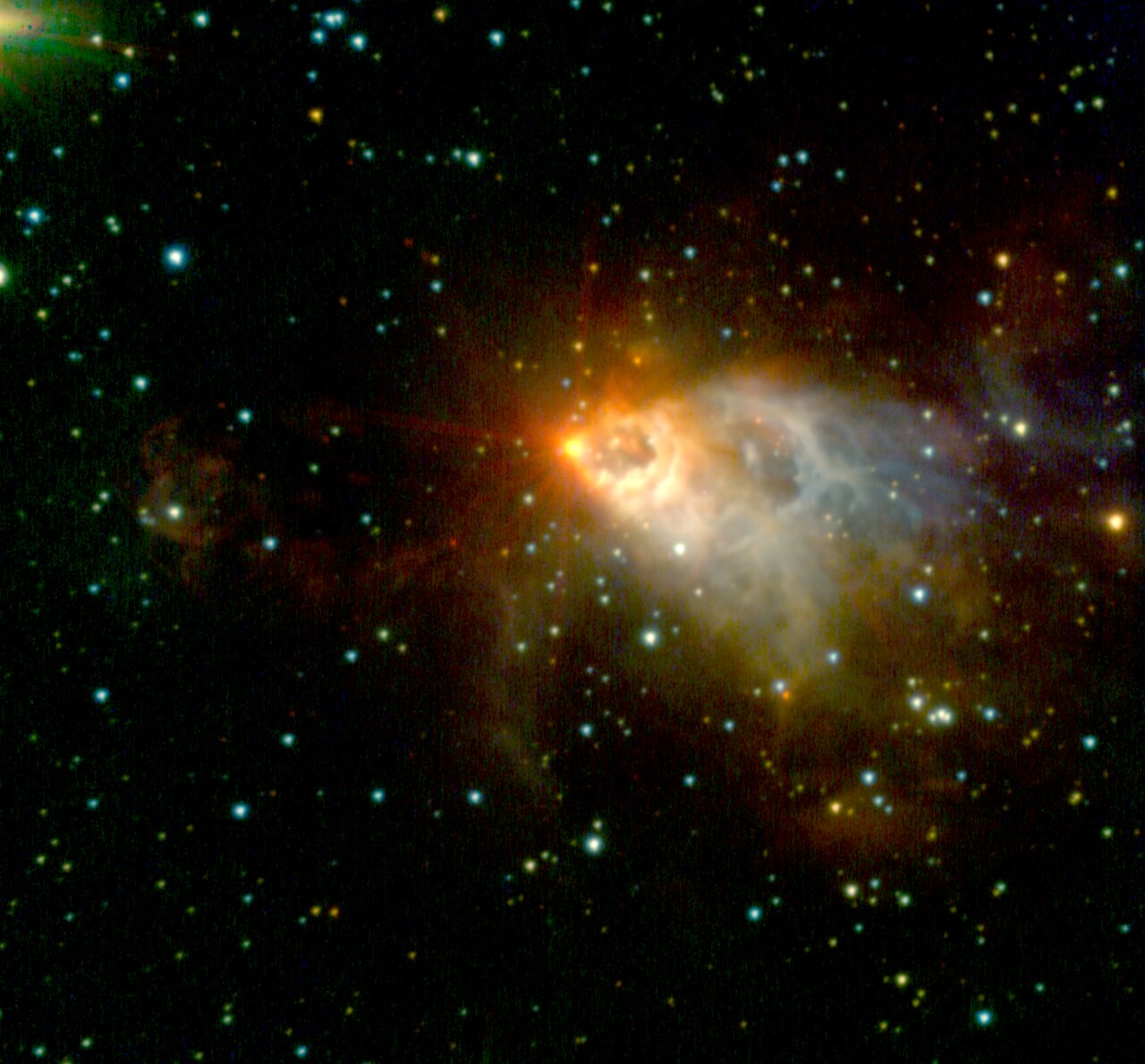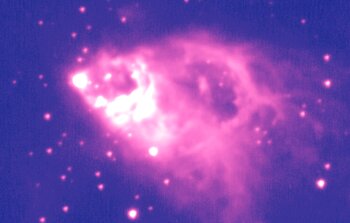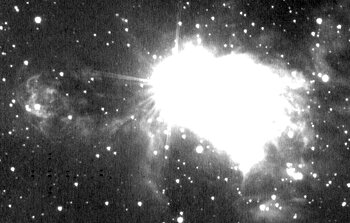Gemini Spies Strong Stellar Gusts in Nearby Massive Star
July 23, 2001

A dramatic infrared image released today by the Gemini Observatory sheds new light on the early stages of the formation of giant stars in our galaxy. The image, taken by the Gemini North telescope on Hawaii's Mauna Kea, reveals remarkable details in a nebula of gas and dust expelled from a young star named AFGL 2591. This expulsion is a common feature in the formation of stars similar in size to the Sun, but it is far less common in their massive counterparts.
"Almost everything in this set of infrared images would be invisible with an optical telescope, since it is occurring within a dense molecular cloud of gas and dust," says Gemini scientist Colin Aspin,who made the observation. "Gemini's unparalleled sensitivity and resolution in the infrared allows us to move beyond simply detecting such structures in general to being able to study them in great detail."
AFGL 2591 is located within the Milky Way more than 3,000 light-yearsfrom Earth, in the constellation of Cygnus. Over the course of the last few thousand years, it has created a vast expanding nebula larger than 500 times the diameter of our solar system. The star is at least10 times the size of the Sun, and over 20,000 times as bright, but perhaps only one million years old.
The wispy white and blue structure in the expanding nebula to the right of the young star is a huge outflow of gas and dust driven by the infall of material onto the star's surface. Gemini scientists believe that the outflow is likely occurring symmetrically around the star - a second giant-sized expanding nebula to the left of the stars hidden from view by a dense and extensive disk (or torus) of material encircling AFGL 2591.
"We strongly suspect the outflow occurs on both sides of the star in abipolar structure, because we detect faint traces of gas at that location which indicate interactions between the outflowing gas and the material forming the parent molecular cloud," says Aspin, a scientific staff member at the Gemini Observatory International Headquarters in Hilo, HI.
"A unique feature of this object is a series of four distinct rings of nebulosity. These rings suggest that the expulsion of the material isn`t constant with time, but rather has occurred several times over the lifetime of the object," he adds. "Studying the structure and velocity of these rings, and their relation to the infalling material,will allow us to better understand why such features are created and what functions they serve."
This striking image is part of a series of early images taken with the Gemini Near Infrared Imager (NIRI) instrument during its commissioning on the Gemini North telescope. Once fully operational later this year, NIRI will be the prime near-infrared instrument on Gemini North.
The color image and others that show hints of the left-hand outflow and more details in the right-hand structure are available on the Internet in various file sizes (different files will go here).
A dramatic infrared image released by the Gemini Observatory (see the press release) sheds new light on the early stages of the formation of giant stars in our galaxy. This image, taken by the Gemini North telescope on Mauna Kea, reveals remarkable details in a nebula of gas and dust expelled from AFGL 2591. AFGL 2591 is located within the Milky Way more than 3,000 light-years from Earth, in the constellation Cygnus. The resolution of these images is 0.4 arcseconds.
This striking image is part of a series of early images taken with the Gemini Near Infrared Imager (NIRI) instrument during its commissioning on the Gemini North telescope. Once fully operational later this year,NIRI will be the prime near-infrared instrument on Gemini North.
More Information
The Gemini Observatory provides the astronomical communities in each partner country with state-of-the-art astronomical facilities that allocates observing time in proportion to each country's contribution. In addition to financial support, each country also contributes significant scientific and technical resources. The national research agencies that form the Gemini partnership include:the US National Science Foundation (NSF), the UK Particle Physics and Astronomy Research Council (PPARC), the Canadian National Research Council (NRC), the Chilean Comisión Nacional de Investigación Cientifica y Tecnológica (CONICYT), the Australian Research Council (ARC), the Argentinean Consejo Nacional de Investigaciones Científicas y Técnicas (CONICET) and the Brazilian Conselho Nacional de Desenvolvimento Científico e Tecnológico (CNPq). The Observatory is managed by the Association of Universities for Researching Astronomy, Inc. (AURA) under a cooperative agreement with the NSF. The NSF also serves as the executive agency for the international partnership.
The Gemini Observatory is an international collaboration that has built two identical 8-meter telescopes. The telescopes are located at Mauna Kea, Hawaii, (Gemini North) and Cerro Pachón in central Chile (Gemini South), and hence provide full coverage of both hemispheres of the sky. Both telescopes incorporate new technologies that allow large, relatively thin mirrors under active control to collect and focus both optical and infrared radiation from space. Gemini North recently began science operations and Gemini South is scheduled to begin scientific operations in August 2001.


